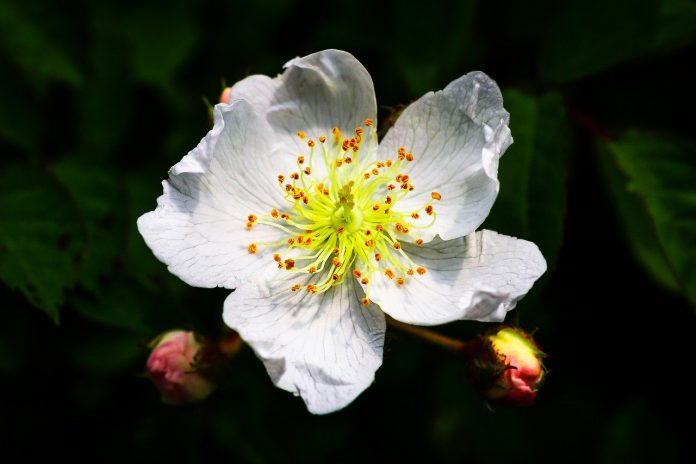A month ago, I was sent to go take care of some poison ivy along the fence line. This was the type of ivy that sends a 12-foot branch off the main vine, threatening the passerby with menacing leaves to haunt your dreams; waiting for you to walk casually by and swipe across your shoulders. A side note: poison ivy is a native plant, and really does contribute excellent color in autumn.
While I was laser-focused on the poison ivy, which was a bit too close to home and family, in the back of my mind I was aware of a plant with white flowers that had appeared this year and that I do not remember noticing on my property in the past. Maybe it was there before, but this year it stood out and my attention was drawn.
Initially, I did not realize what I was staring at, but I saw thorns and decided it had to go along with the poison ivy. It would not do any good to get a poison ivy rash and get hooked by a thorn while cruising by on the mower. I had, I now realized, a few guest plants of multiflora rose finding a way out through the tangle of other plants on the field edge.
Multiflora rose
This past May and into June, the multiflora roses were flowering vociferously throughout my section of the world in southeast Ohio. This has always been known as a problematic woody shrub and is widespread in much of the U.S., with an early history of intentional planting despite our current wish that it never was here.
Dense stands severely reduce pasture grazing for cattle and other livestock, and it ranks high on the list of plants that any livestock manager needs to invest time in controlling. All those flowers on multiflora rose produce prolific amounts of seed which can be viable for 20 years.
Long canes that grow out and bend back toward the soil can re-root and form new plants through a process called layering. One plant, left unchecked, will become a dense thicket. I am hoping that my one-off herbicide treatment will stop this plant in its tracks. But in a recent check of fact sheets and literature, I am quickly reminded it may not be that easy.
Again, seed banks can increase rapidly and the plant can readily resprout from the roots, despite a foliar herbicide treatment. Many of us know some places where the landscape is full of this plant.
Management
Knocking back woody perennials like multiflora rose takes effort. Proactive weed management is really the best approach in any pasture or fence line.
Many of our classic recommendations that come out of extension efforts, or from a seasoned farm manager, hold true and will prevent these weed problems from the start. Fertility management and matching forages species to the site are tried and true.
Preventing overgrazing is important for a variety of reasons and impacts weed control immensely. Scouting and following up with spot controls before young plants become well established will pay dividends in time. You can graze around multiflora rose for a time, but a proactive management approach is warranted.
In many cases, just mowing will not be enough to solve a potential problem. Mowing requires activity all season to constantly defoliate the plant to starve it of resources. Mechanical removal is only effective if all root buds with shoots are removed, which can be tough to accomplish.
Herbicides
As a result, herbicides are usually required at some point to get the job done, especially if several plants are targeted. If you are tackling a woody brush problem, take a moment to catch up on which pasture herbicides can work for you.
Penn State Extension and Ohio State University Extension both have resources that discuss options in foliar, basal bark, and cut stump treatment of multiflora rose and you may already have something on hand that is a useful option. Proper timing of an application may also be necessary for effective results.
In general, basal bark and cut stem treatments are projects that can happen any time of year while foliar treatment is naturally restricted to May to September when leaves are on the plant. I like the recommendation to work from the least to the most invaded areas in order of priority, which maximizes the potential of uninvaded areas and prioritizes existing ecological value.
If plants are of a small enough size, mowing followed by herbicide treatments should be effective. But again, this is a plant that you should plan a specific treatment for, so make the investment to time your activities accurately.
Weed and brush management are only part of the whole complex of grazing. Find a pasture program or field day in your area and get out and talk with other managers about their successes and missteps on challenges like these. We have a Beef Field Day coming up in Muskingum County on July 16 featuring a variety of conversations on cattle management and industry topics.
Any given year, I will have conversations about multiflora rose, autumn olive, ailanthus, poison hemlock and other classics that persist in our landscapes and require some of our time to keep in check. There is almost always someone else who has tried a technique before you have, so a few conversations usually go a long way before embarking on a project.













